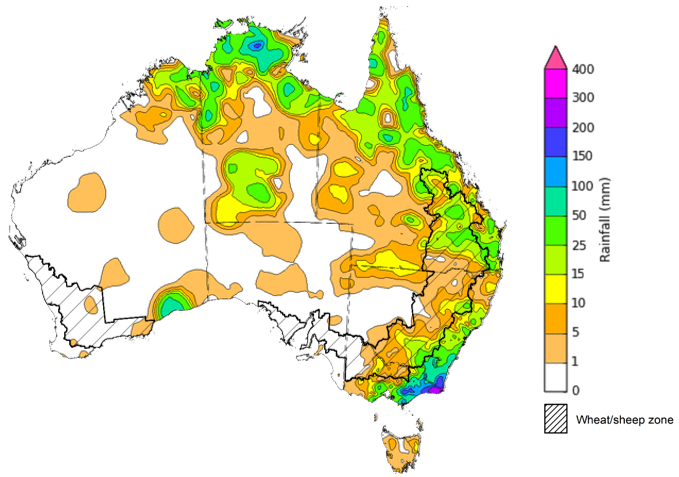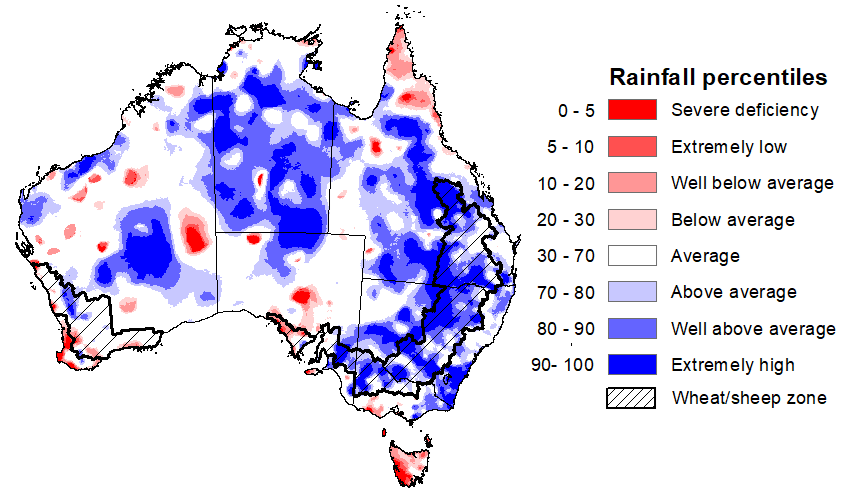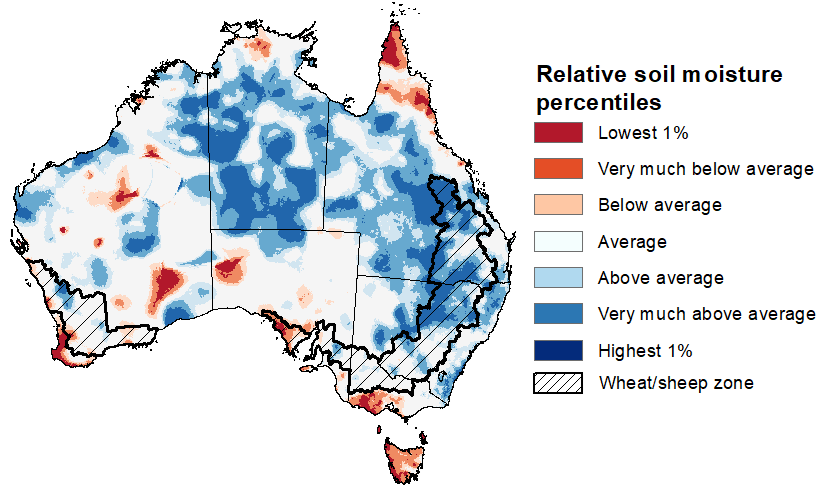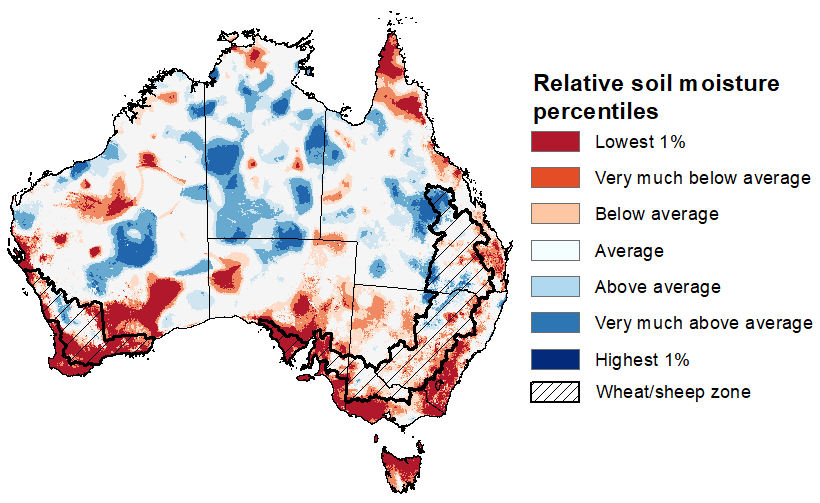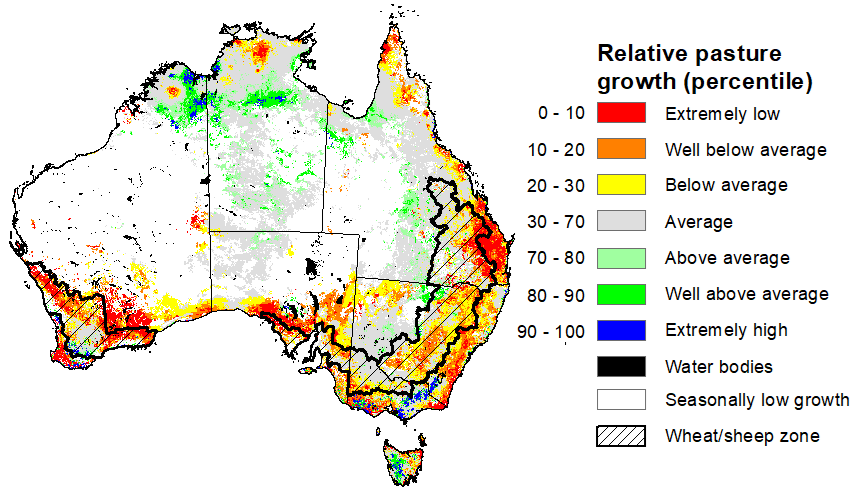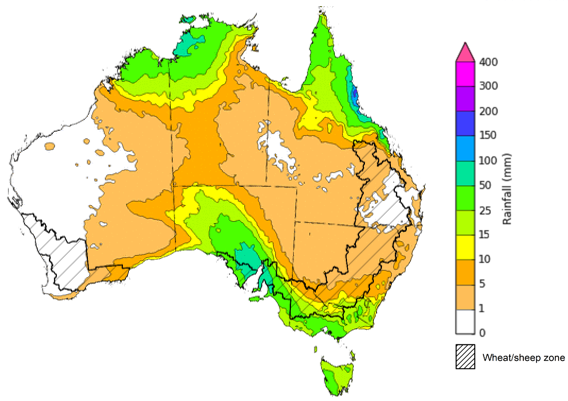Key issues
- For the week ending 6 December 2023, widespread shower activity over south-eastern Australia and troughs over northern Australia brought significant rainfall totals.
- These falls will likely provide sufficient soil moisture to allow for the widespread sowing of dryland summer crops in Queensland and northern New South Wales.
- Significant rainfall elsewhere in is expected to provide a boost to soil moisture levels and pasture growth rates and availability.
- November 2023 rainfall totals were close to 40% above the national long-term average.
- These falls have resulted in average to above average upper soil moisture across much of Australia.
- Lower layer soil moisture is still very much below average across large areas and will require more rainfall to build up reserves for next winter’s crops.
- September to November modelled pasture growth was generally below average in southern Australia mainly from the dry September and October in many areas.
- However, rainfalls in November and early December should provide a boost in pasture growth and will likely enable farmers to slow destocking activities and boost paddock feed leading into summer.
- Over the coming week, troughs and fronts will generate storms and showers in tropical north and southern areas.
- Significant rainfall in South Australia, Victoria and southern New South Wales will likely further delay harvest of remaining winter crop and may downgrade grain quality but should help build soil moisture reserves for pasture growth and the next cropping season.
- Dry conditions in Queensland and northern New South Wales cropping areas will allow easy field access for summer crop planting activities.
- Water storage levels in the Murray-Darling Basin (MDB) increased between 30 November 2023 and 7 December 2023 by 83 gigalitres (GL). Current volume of water held in storage is 15 986 GL. This is 7 percent or 1238 GL less than at the same time last year.
- Allocation prices in the Victorian Murray below the Barmah Choke increased from $99 on 30 November 2023 to $110 on 7 December 2023. Prices are lower in the Goulburn-Broken and regions above the Barmah choke due to the binding of the Goulburn intervalley trade limit and the Barmah choke trade constraint.
Climate
For the week ending 6 December 2023, the major storm system that brought widespread rainfall in late November continued its passage over south-eastern Australia generating rainfall totals of up to 300 millimetres in the eastern parts of Victoria extending up to south-eastern New South Wales. Troughs over northern Australia resulted in rainfall totals between 25 to 200 millimetres. In contrast, large areas in Western Australia, South Australia, Tasmania and western New South Wales remained relatively dry.
Across eastern cropping regions, rainfall totals of up to 50 millimetres were recorded in Queensland and southern and eastern parts of New South Wales. These falls will have further boosted soil moisture reserves, supporting the development of summer crops and pasture growth. This will likely result in a reduced reliance on supplementary fodder to maintain the production of livestock and livestock products. The falls across Queensland would have prevented field access for the planting of summer crops.
Rainfall for the week ending 6 December 2023
After several months of below average rainfall nationally, November 2023 rainfall totals were close to 40% above the national long-term average. Rainfall was generally average to above average across much of Australia, with exception of the tropical north of Queensland, scattered areas of central and Western Australia, and Tasmania where below average November rainfall was recorded.
In cropping regions, November rainfall was largely above average in the eastern states, and generally average in Western Australia and central South Australia. While November rains has delayed the harvest of winter crop and likely lead to grain quality downgrade, the build-up of soil moisture reserves across the nation will benefit pasture growth and summer crop production.
Rainfall percentiles for November 2023
Upper layer soil moisture in November 2023 was average to extremely high across much of Australia. The exceptions being Tasmania, southern Victoria, tropical Queensland and Northern Territory, and in patchy areas of South Australia, Western Australia where it was extremely low to below average.
At this time of year, upper layer soil moisture is important at the beginning of the summer cropping season and for pasture growth across northern Australia since plant germination and establishment utilise this moisture. It is also an important indicator of the ability to access paddocks for winter crop harvesting and summer crop planting activities.
Upper layer soil moisture was above average to extremely high for this time of year across most cropping regions in New South Wales and Queensland. While welcomed these high levels of upper layer soil moisture in New South Wales and Queensland are likely to have interrupted harvest completion and impeded access for the planting of summer crops.
Modelled upper layer soil moisture for November 2023
Relative lower layer soil moisture for November 2023 was extremely low below average across the southern and eastern margins of the country as well as parts of tropical Queensland and Northern Territory and central Western Australia.
Lower layer soil moisture is a larger, deeper store that is slower to respond to seasonal conditions and tends to reflect the accumulated effects of events that have occurred over longer periods. At this time of year increased levels of lower layer soil moisture will be important to support summer crops and pasture growth during a peak growth period.
In cropping regions, lower layer soil moisture was below average in large areas of South Australia, southern Western Australia, and in patchy areas of eastern New South Wales and Queensland. It was average to above areas in the remaining cropping regions. High lower layer soil moisture levels during November provides a reserve of plant-available water for summer crops later in the growing season.
Modelled lower layer soil moisture for November 2023
Pasture growth during the September to November period is typically low across large areas of central and northern Australia as it is nearing the end of dry season. Across southern Australia, September to November is the peak pasture growth period which typically provides a bulk of feed and allows for fodder conservation to maintain production through the low pasture growth months of summer. It also influences the growth, branding and marking rates of lambs and calves, and the production of meat, milk, and wool over this peak production period.
Below average rainfall and above average temperatures during September and October 2023 resulted in well below average pasture production for this time of year across many grazing regions in eastern and southern Australia. In contrast, rain spread across the past three months in western New South Wales, much of Victoria and Tasmania resulted in average to extremely high pasture production.
In those areas that recorded average or better levels of pasture production, graziers will likely be able to maintain stock numbers and provide opportunities to replenish fodder supplies during early summer. In contrast, modelled pasture growth was below average across large areas of New South Wales, southern Queensland, and in southern South Australia and Western Australia. Many of these areas, however, should see a rise in pasture growth from the November and early December rains and enable these graziers to slow destocking activities and boost paddock feed leading into summer.
Relative pasture growth for 3-months ending November 2023 (1 September 2023 to 30 November 2023)
Over the 8 days to 14 December 2023, troughs are expected to generate showers and storms across the tropical north and south-eastern Australia. Rainfall totals are forecast to be in the range between 25 and 100 millimetres in some areas and up 200 millimetres in coastal Queensland associated with the development of Tropical Cyclone Jasper. Cold fronts are expected to bring rainfall of up to 50 millimetres in Tasmania.
Tropical Cyclone Jasper in the Coral Sea is expected to strengthen further over coming days. At this stage the severity of the impact remains uncertain but the potential for gale force winds and heavy rainfall presents a high risk to the production of horticultural and other high value crops such as sugarcane.
Across cropping regions, rainfall totals up to 100 millimetres are forecast for South Australia and up to 50 millimetres across Victoria and parts of southern New South Wales. While these falls will benefit with build-up soil moisture reserve for pasture growth and next cropping season, they will likely further delay the harvest of remaining winter crops and may downgrade grain quality. Little to no rainfall in Queensland northern New South Wales will provide improved access to fields for summer crop planting.
Total forecast rainfall for the period 7 December to 2023 to 14 December 2023
Issued 7/12/2023
Note: This rainfall forecast is produced from computer models. As the model outputs are not altered by weather forecasters, it is important to check local forecasts and warnings issued by the Bureau of Meteorology.
Water
Water storages, water markets and water allocations - current week
The Tableau dashboard may not meet accessibility requirements. For information about the contents of these dashboards contact ABARES.
Commodities
Information on weekly price changes in agricultural commodities is now available at the Weekly commodity price update.

